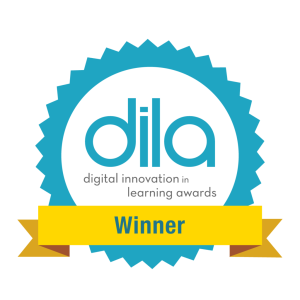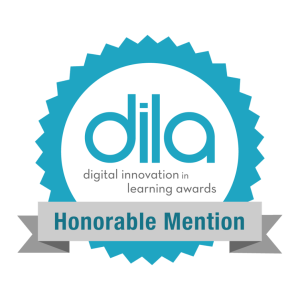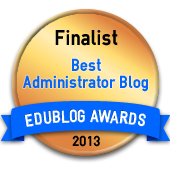Blog Archives
3 Questions I Hope my Children’s Teachers are Asking
I often reflect upon how to empower students to learn at a high level while navigating the digitally-connected landscape we find ourselves in. I ask questions and strive to serve our students better today than I did yesterday.
In addition to being a principal I’m also dad to three pretty spectacular kids. My wife and I pray our children grow up to be loving people with humble hearts and curious minds. We also understand that their world is different than ours was, so we think about other important things too. My hope is that my children’s teachers are reflecting on some of the same questions I ask myself.
3 Questions I Hope my Children’s Teachers Are Asking
- How might I model digital leadership for my students?
- How might I help my students express their ideas in powerfully creative and appropriate ways using social media?
- How might I leverage the transformative power of technology to fuel collaborative conversations between students about their learning?
For the past couple years I’ve collaborated with Tony Sinanis and John Fritzky (principals in New York and New Jersey) to create cross-state collaborative podcasts. The podcasts feature our students sharing their favorite books, vision for education, and other creative endeavors led by kids.
This year we are adding an interactive Twitter-based chat to the collaboration. We’d like to invite you to join us as we strive to model how to leverage technology as a tool to connect, inspire, and amplify student voice.
The four chat dates for the 2015-2016 school year are below, and we’re planning to share out a student-created podcast prior to each chat. Please join us and include your classroom or school in the conversation. We’ll be using the hashtag #StuConnect on Twitter starting at 9:30am CST on the dates below.
#StuConnect Chat Dates
October 8, 2015
December 1, 2015
January 15, 2016
March 10, 2016
1 Page Dissertation
 This past week a friend shared his doctoral findings on Twitter in a single-slide summary. I thought the idea was brilliant. The simplicity of a single graphic can be a great catalyst for conversation and reflection. At the same time, it can potentially over-generalize by removing important context about the research methodology. My research involved some of the most innovative elementary principals in the country, and they do not necessarily represent all elementary principals. Click HERE to access my entire dissertation.
This past week a friend shared his doctoral findings on Twitter in a single-slide summary. I thought the idea was brilliant. The simplicity of a single graphic can be a great catalyst for conversation and reflection. At the same time, it can potentially over-generalize by removing important context about the research methodology. My research involved some of the most innovative elementary principals in the country, and they do not necessarily represent all elementary principals. Click HERE to access my entire dissertation.
*Hat tip to Tony Sinanis for the idea to make a 150+ page published research document more accessible to others!
It’s On!
I was recently invited to participate in a blogging challenge. Terri Eichholz threw down the gauntlet and I can’t resist a good challenge (especially when it involves collaboration and my own professional learning).
The premise of the challenge is to name a practice or idea that I adapted from somebody in my PLN, and to follow-up by challenging three more educators to do the same. My response is a resounding, “It’s on!!”
The ideas that I “borrowed” actually came from ten different educators and highlight the power of collaboration made possible via Twitter. You see, each of these ten AMAZING people from across the country shared three mini-challenges designed to help other educators hone their technology skills.
All of this sharing culminated in an epic PD opportunity for you. The ten educators helped create the “Digital Leadership Challenge.” Click HERE to read the mini-challenges. I encourage you to participate with us by working your way through any of the challenges over the next several months.
As part of the #LMSChallenge, I’m passing the torch to three (3) groups:
1.) The ten original collaborators on the Digital Leadership Challenge
2.) The 80+ educational leaders that have signed-up already to participate and grow their Digital Leadership
3.) The Minnesota Elementary Principals Association #MESPAmn
I challenge educators in these groups to blog about an idea they implemented or adapted from somebody in their PLN and post it to Twitter using the hashtag #LMSchallenge. Whatever you do, don’t forget to join us in taking the Digital Leadership Challenge. Sign-up HERE and choose which of the 33 mini-challenges you’ll participate in. This is personalized PD on steroids, and we’ve got a great group collaborating on the challenges.
Make it a great day…and NEVER stop learning!
Empowered Learning: Transforming the PD Paradigm
Power Plant PD

Image Credit: http://www.providenceri.com
I’m currently immersed in a doctoral study involving some of the most innovative and effective school leaders in the country. My research is focused on the Professional Development (PD) experiences of elementary principals in a digital age. The process of reviewing hundreds of peer-reviewed research articles and talking to countless practitioners in the field of education has been a deeply reflective exercise. I’ve been convicted of some of my own personal PD leadership failures, and I’m also gaining clarity on what I believe we need to do to create conditions in which teachers are supported in their learning.
We’ve been conditioned to believe that attending a dynamic presentation or well-organized workshop is the gold standard for PD. The traditional PD paradigm espouses that an “expert” in the field can share information about a topic with an audience, and that this transmission of knowledge will increase an audience’s capacity, motivation, etc. We’ve relied on this “Power Plant” approach to PD for several decades. This type of PD may recharge our batteries for a period of time, but it is unlikely to cultivate an educator’s long-term ownership of his/her learning.
“Power Plant PD” may have represented best-practice and sound pedagogy in the past. However, it’s the same approach we are asking our classroom teachers to migrate away from. We want students authentically engaged in relevant learning that includes opportunities to hone 21st century skills like communication, collaboration, creativity, and critical thinking. To usher in a new learning paradigm the predominant voice in the room must include our students’ voices. Why would principals and PD planners hold themselves to a lesser standard?
Empowered Learning
The most powerful PD comes when the learner is empowered…not the presenter. Teachers who are empowered are conduits for high-voltage learning. They possess an authentic yearning and fervor for growth that cannot be completely satisfied through traditional presentations.
If we are to foster an ethos in education in which staff learning is truly revered our teachers will no longer be treated like batteries needing a quick recharge. Teachers will be honored as the true “sparks” in our schools and connected with other educators across the globe. A powerful connected-pedagogy will emerge that supports teachers in securing the time and skills needed to collaborate.
In order effectively leverage the student-centric connections made possible by technology including social media, it’s critical that we are engaged in our own digital age learning. Each of us is a digital leader…the only question that remains is, “How effective and relevant are we in this role?” I’d encourage you to check out the Digital Leadership Challenge blog post and sign-up to participate in the personalized mini-challenges using the Google Drive link embedded within. If we don’t walk-the-walk and own our learning how can we expect anyone else to?
Finally, here are four additional PD questions I’m encouraging educational leaders to reflect upon. I’ll be holding myself accountable to the same four questions and encourage you to check back with me. I can’t think of anything more important than empowering the true “sparks” that are working with our students every day. Transforming the PD paradigm is paramount to supporting student learning in the digital age. We need to rethink the very definition of Professional Development; PD can be a conversation, EdChat on Twitter, written reflection on a blog, flipped faculty meeting followed by purposeful face-to-face time, or an asynchronous dialogue via Voxer. We must empower our people!
4 Questions
1.) If the PD and/or staff meetings you plan were optional would your staff still show up?
2.) How might we more effectively model current-best practices in PD; the same practices we’d expect our students to benefit from in the classroom?
3.) Is the topic of failure regularly discussed and modeled? Do staff understand the explicit value of failure in the learning/growth process?
4.) How are we leveraging technology and social media as tools for personalized learning? How are we supporting staff on this journey?
Finding Twitter
Since finding Twitter, my professional growth and love of learning has been supercharged. Being a “connected educator” has contributed to my being able to more effectively serve our school while increasing my ability to provide digital leadership.
Twitter provides me 24-7 access to research on best practices, blogs from innovative teachers, and information about communication tools that principals are using across the country. Best of all, I have access to the creative work that authors, educators and parents are sharing around the globe thanks to the Professional Learning Network (PLN) we’re building. Twitter allows me to share some of the amazing things that our talented staff and students are doing every day as well.
It is difficult to explain the sensation of being a connected educator until you’ve experienced the impact first-hand. Instead, I offer an analogy that comes pretty close in the hopes you will consider getting connected.
Do you remember the East Australian Current (EAC) scene from the movie, Finding Nemo? That rapid and exciting ocean current that connects warm water from the tropical Coral Sea down the east coast of Australia is very much like Twitter. Those that are not a part of the EAC never really miss it…yet they may be missing out on the trip of a lifetime.
Let me explain. The fish that are meandering happily outside the EAC are perfectly content. In fact, they are probably thriving just like many amazing educators that have not discovered the power of Twitter yet. (Just like me before I took the plunge!) Once a fish breaks through the initial confusion and misperceptions of the EAC he’s in for the experience of a lifetime…just like Twitter.
I’m often inspired as I visit classrooms in the school I serve. The work that teachers are doing is truly amazing. Twitter is a tool that allows each of us to share our experiences and connect to others for additional support and perspective. Chances are that YOU can add value to somebody else’s PLN too!
Consider expanding your bubble and growing your PLN. When educators collaborate on their craft and embrace a learning mindset our students win!
Image Credits: Disney/Pixar
The Great Character Carving Challenge! (Powered by AR)
Looking for a way to integrate cooperative learning, research, tech integration and FUN into a super cool “autumnal lesson of awesomeness?!?” Click the link below to take the challenge!
Great Character Carving Challenge
Several years ago I combined my passion for art and reading to create some “Literacy-o-Lanterns” that were displayed in our Media Center. The tradition continued each year until I had amassed quite a few pumpkin pics. Through collaboration with our school’s magnificent Media Specialist, talented Technology Para-professional and book recommendations from my own children the project evolved into this year’s challenge.
The challenge is simple…students are to work cooperatively in teams to complete a chart representing various authors and storybook characters. The characters range from classics to newer student favorites! This activity is ideal for a classroom that has access to at least one digital device for research (iPad, BYOD, or desktop computer). However, technology is not required to participate. This year we’re taking the fun to a whole new level using Augmented Reality (AR).
You might be wondering, “What’s the deal with this Augmented Reality stuff I keep hearing about?!” FANTASTIC Question!! The Great Character Carving Challenge is powered by AR. This means that if you follow three easy steps your students will be able to access some additional book clues and YOU will be able to see this lesson’s learning targets. The technology has been meaningfully integrated into this activity to engage students and to support their learning. Besides that….AR is just plain cool! For me, the technology represents possibilities, creativity and new learning (all really good things if you’re a principal).
You’re just 3 Quick Steps away from using AR:
1.) Download the app called Aurasma on a mobile device.
2.) Using your mobile device, go to http://auras.ma/s/cqE9t
3.) Open the Aurasma app and aim viewfinder at the pictures of the pumpkins on the PDF (see link above)!
**If you need ANY support in accessing AR please don’t hesitate to contact me via Twitter @GustafsonBrad.
Some of the “Clues & Book Facts” spaces on the chart have been left intentionally blank…they’re open-ended for a reason. Use the blank spaces to customize this activity to skills your students are working on (author’s purpose, genre studies, digital citizenship and more). Challenge students to dig into their research and cite multiple sources as time allows! I’ll update this post closer to Halloween with some possible answers for the chart that’s on the PDF. Here’s the link to the challenge once again…HAVE FUN!



























